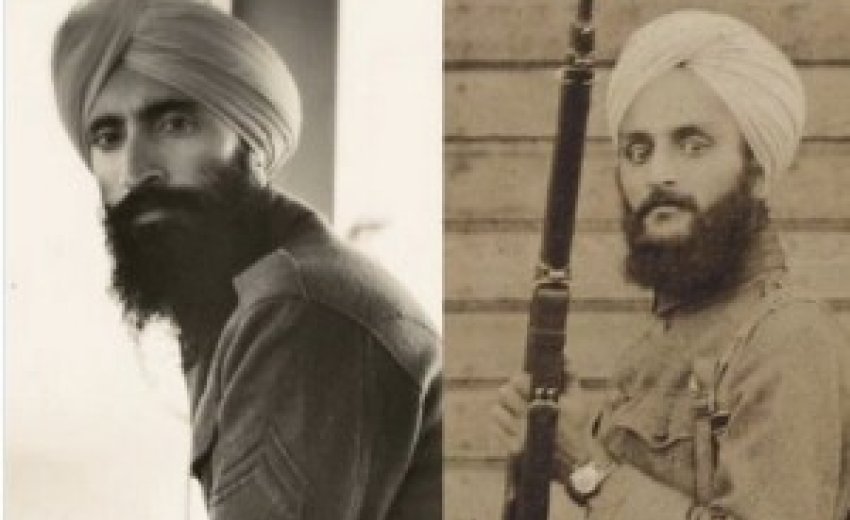Waris Singh Ahluwalia is a name known to many, or at least almost everyone must have seen him once in a while somewhere - be it on a magazine cover, in newspapers or on social media. Imagining a Sikh bearded turbaned man as a model was not easy some years ago, but Waris made it a reality. Over time, he has been featured in magazines, a jewellery designer, and appeared in three important Hollywood movies directed by famous directors like Wes Anderson and Spike Lee.
Early life
Waris was born in Amritsar, but he grew up in Brooklyn. Later, he started living in the West Village of Manhattan. He usually dresses nicely, wearing a dark brown suit, a black turban, and striking green leather gloves. When he was five, he moved from Amritsar to New York and grew up in Bay Ridge, Brooklyn. He remembers, "I was perhaps the only Indian kid in my elementary school, forget about other Sikh kids." Growing up in Brooklyn, far from the Sikh communities in other parts of New York, Waris missed having friends from a similar cultural background.
He used to go to Sikh camps during the summer and met Sikh kids from different parts of the country. He was always amazed that these kids grew up with friends who were similar to them. He even begged his parents to move to Maryland at one point so he could hang out with the friends he made at camp.
Changing perspective about the Sikh turban
College life at a small liberal arts college in upstate New York made Waris feel somewhat isolated. He recalls that he was one of just a few Sikh, Indian, or South Asian students there. He often wore a bandanna instead of a turban to class, not only because it was more convenient but also because he didn't want to stand out too much in a college where he was the only Sikh student.
Everything changed when Waris spent a year abroad at the University of Manchester. He was amazed by the lively Sikh culture in England and felt proud to be surrounded by many other young Sikh students who wore turbans. This experience encouraged him to start wearing his turban every day.
After his year abroad, he came back to New York. After just two job interviews at advertising agencies, he realized that a regular job wasn't his calling. He decided to explore various paths, focusing on his passion for music. He attempted to launch a music magazine but abandoned the project after a year because it didn't align with his interests.
He then began organizing parties and events, frequently going out with friends to clubs and concerts. During this time, he became exposed to the New York art scene, meeting established artists pursuing innovative projects. In many ways, this was his true education.
His involvement with the New York Yearbook Project, which was like a high school yearbook for the arts in New York, followed. He reflected on his twenties as a period of exploration, trying out different endeavours to figure out his life's direction. He enjoyed immersing himself in various activities, always seeking to understand how they functioned if they captured his interest for more than a day.
The standout act
In the 1990s, during a recession in the U.S., Waris had a quirky idea. He wanted to wear diamonds as a kind of social statement. He thought that while everyone was complaining about tough times, why not go the opposite way. So, he got in touch with a friend who worked in New York's jewellery district and had them create some diamond rings based on his designs.
During that winter, while he was in Los Angeles to escape the cold New York weather, Waris visited Maxfield's, a fancy boutique popular among Hollywood stars. The shop owner noticed the diamond rings on Waris's fingers and asked about them. This led to an interesting turn of events. Waris left Maxfield's with an order for rings just like the ones he wore, to be delivered within a week. When he supplied the store with those rings, they quickly sold out. Before long, the fashion press took notice, and Waris's career as a jewellery designer began.
According to him, he had no experience in jewellery design when he started. He used to provide his sketches to the craftsmen, and they would create the final pieces. However, due to his strong desire to understand the entire process and become deeply engaged in every project, he dived in and got a comprehensive understanding of the business.
Rising to recognition
Waris collaborates with skilled craftsmen in both Italy and India to create his celebrated pieces. These pieces are available at exclusive stores worldwide, including Barney's in New York and Collete in Paris, all under his brand, House of Waris. His creations range in price from $1,200 to $150,000. While House of Waris prefers to keep its client list private, famous individuals like Kate Hudson, Maggie Gyllenhaal, Natalie Portman, and Wes Anderson have been spotted wearing Waris' designs.
In 2009, he was one of the designers nominated for the prestigious Vogue Fashion Fund Award for young designers. Waris' journey into acting began unexpectedly. In 2003, during a dinner with Hollywood director Wes Anderson, Anderson invited him to appear in his next film.
Anderson sent Waris the script, and a few weeks later, he went to Italy to film the highly praised movie, "The Life Aquatic with Steve Zissou." He mentioned that he had heard that working on a Hollywood production could be tough, with people pushing you hard to perform. However, his experience was quite different. Everyone on the set was very supportive. The cinematographer would approach him after a shot and say things like, 'That was fantastic... it looked like a painting by Caravaggio,' and so forth.
Waris has appeared in two more Hollywood films. He was in Spike Lee's Inside Man and Wes Anderson's The Darjeeling Limited. He stays busy with films. He worked on an Italian film called Io Sono Amore, which premiered at the Venice Film Festival and will be in theatres later this year. He also worked on an independent film, ‘Rosencrantz and Guilderstern are Undead’.
He keeps working on his jewellery and plans to introduce two new product categories this year under his brand, House of Waris. He also has plans to open the first House of Waris flagship store.
House of Waris is about working with the best craftsmen in the world and creating beautiful things. He said jewellery is intimate - when it's made in Old Rome in a cave or Rajasthan, there's a romance to it, a story behind it and he makes jewellery because he wants to experience that. More than a jeweller, more than anything else, first and foremost he believes that he is a storyteller.
The Adventures of 'le chic Sikh' in Hollywood.
Waris stands out as the only turbaned Sikh in Hollywood, and he understands the benefits of this unique position. Waris has taken on the role of representing his tradition responsibly. He has never attempted to blend in and has even declined film roles that require him to conform to stereotypes. Fortunately, no one has ever asked him to do anything offensive related to his ethnicity.
People call him the 'chic Sikh,' 'punk maharajah,' and even compare him to Indiana Jones during a photo shoot for Turkish Vogue. He collects these nicknames as quickly as he adopts different identities.
Waris is known for his unique roles in movies, though he hasn't shown a wide range yet. He brings a special touch to his characters, making them quirky and funny. Fans of Wes Anderson's films find him memorable on screen. In "Inside Man," he held his own against stars like Denzel Washington and Jodie Foster, proving himself as a scene-stealer. Spike Lee discovered him through Willem Dafoe, his co-star in "Life Aquatic." There's Oscar buzz for his role in "Inside Man" this year.
Waris also has a film, "I am Love," at Sundance, starring Oscar winner Tilda Swinton. He's gaining popularity among both Hollywood heavyweights and indie enthusiasts. In April, "Rosencrantz and Guildenstern are Undead," a unique comedy blending Shakespeare and vampires, will be released. Waris believes in vampires, and he's confident about it.
"Maybe that's a part of my Indian heritage. If you can get into a car in India and drive and believe you're going to get where you're going, you believe in everything. Who'd have thought this - I'm going to act in some major films, I'm going to work with half a dozen Oscar winners. I've never even trained as an actor." Waris said in an interview.
*Based on an article by Aditi Saxton, published in Sikhchic.com 24th February 2010

